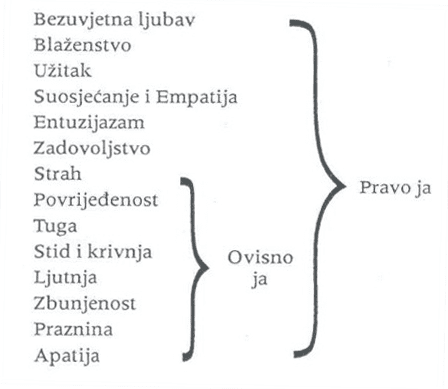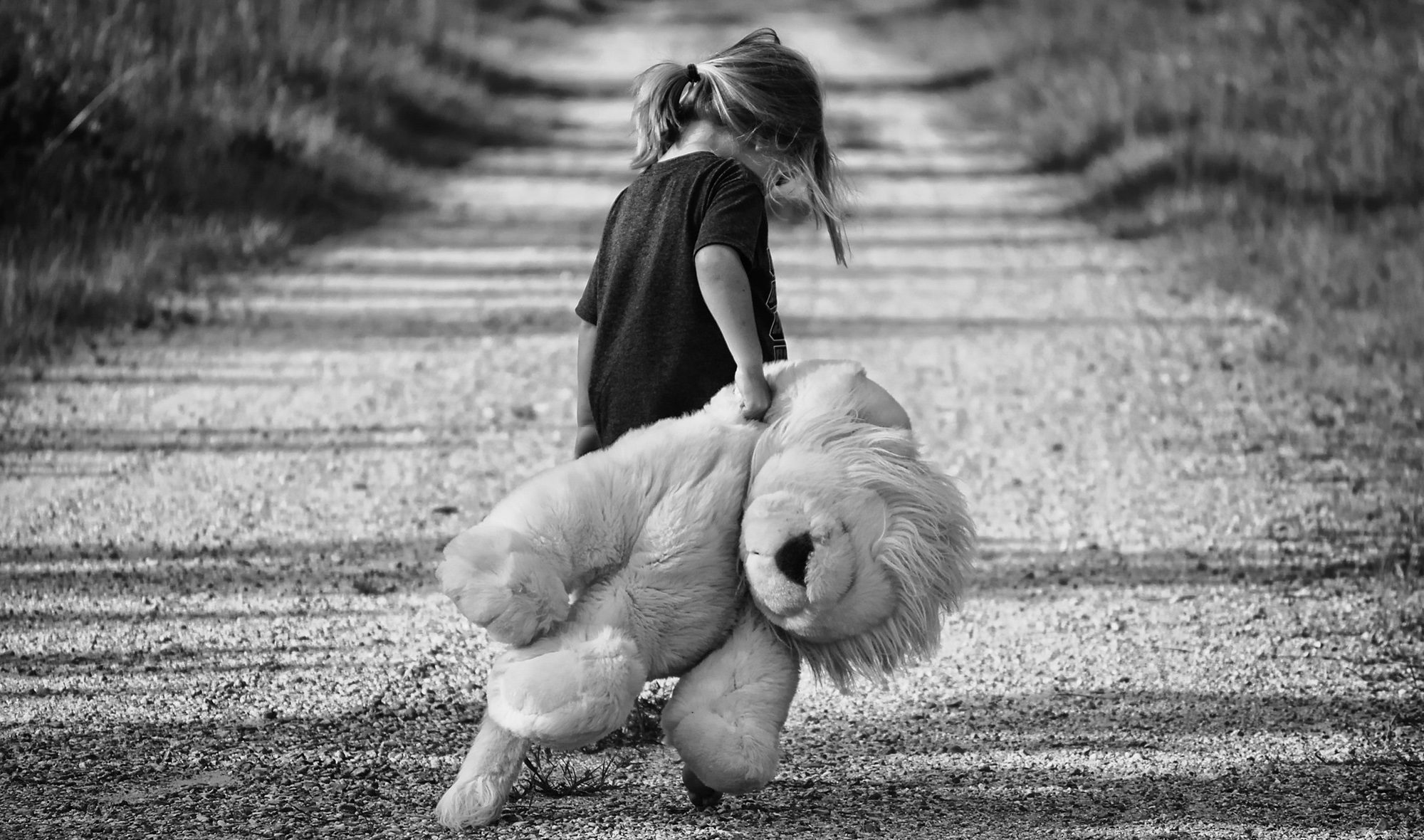How to comfort the child within us?
In the process of healing a child, it is crucial to become aware of the feelings that we suppress or are unaware of. We hold on to the position of the victim and are not aware of our wholeness, we do not feel alive. By working on ourselves, we can start to feel repressed emotions again. Assuming that they are very painful, we avoid them, but paradoxically, when we come into contact with them and when we get to know them again, we can start to enjoy them despite the fact that they are still painful. But at least we feel alive and whole.

In order to more easily cope with unmet needs in childhood, a person tends to limit himself only to the DEPENDENT SELF. By doing so, we limit the possibilities of feeling a whole additional spectrum of feelings, because these feelings were simply forbidden or not allowed in some way. By getting to know the true self, we can only begin to develop mentally, emotionally and spiritually, and only when we reach that spiritual level, can we be more intimate with others and share more painful content and emotions.
SHARRING EMOTIONS
This can be slippery terrain, if we share emotions with the “wrong” people, the result can be much more painful than it already is. If we share with someone who is not trustworthy, makes us change our feelings, does not support us, there is a possibility that we will be rejected, there is a possibility that we will be betrayed…
https://feelandhealtherapy.org/microdosing-studies-that-indicate-effectiveness/
HOW TO DECIDE WHO TO CONFUSE AND WHO NOT?
With the share-check-share technique. If we want to share something, we share it but in a very small volume, we offer only a small piece of the problem we have and we check the response. And then if we feel that we are not being listened to, if they try to deny our feelings or reject us or betray us, they are not trustworthy. If we are heard, if we are supported, then we can share more.
With a greater awareness of observing our feelings, we discover a healing principle, which is that we are not the same as our feelings. Although they are crucial to our vitality, we can only observe them at the same time. They neither take over us nor rule us. And only at that point of acceptance, can we start with the next step in the process, which is reshaping our feelings.
REFORMING OUR FEELINGS

Every feeling has its opposite and only when we become aware of all painful and negative feelings and after experiencing and releasing them can we transform them into feelings of joy.
Our feelings work in accordance with our will and mind and help us live and develop. If we block them, we also block the flow towards their natural ending (every emotion has its beginning and end). And that is why blocked feelings can cause anxiety and illness. If we work them out, on the contrary, we will be healthier and achieve tranquility and inner peace. And in all of this, it is crucial to give yourself time. We deal with painful feelings through those same painful feelings, and that is why time is needed.
Our feelings are part of the key driving force in our development, which is grief. When we lose something that we see as precious, we have to grieve it.
HOW TO GET OVER LOSS
We experience loss when we are deprived of something, or have to be without something that we needed, wanted or expected. Minor losses or minor traumas are common. However, all our losses cause some kind of pain and it is necessary to get over something, to let go of the loss, to process it and let it go. And that takes time and people who support us in doing so.
THE DANGER OF UNOVERCOMING LOSS
Every loss triggers energy in us that we have to get rid of. If we don’t do this, stress becomes chronic. This is a state of chronic shock. If we do not release it, chronic stress will be stored within us as chronic anxiety, tension, fear or nervousness, anger, sadness, emptiness, difficulty sleeping, and even complete mental blocks and physical illnesses or so-called “compulsions”, where it seems as if something is forcing us to do things that are not good for us.
First, we need to recognize our losses, then we can start to relive them and finally move past them and get over them, instead of avoiding them.
THE BEGINNING OF GRIEVANCE
- Recognizing our losses
- Recognizing our needs
- Recognizing our feelings and sharing them with someone
- Working on key issues
- Working on a recovery plan and program
RECOGNIZING OUR LOSSES
Significant person – close or deep relationship: Separation, divorce, rejection, infidelity, abandonment, death, abortion, illness, moving, children leaving home, etc.
Part of our personality – physical appearance, illness, accident, loss of function, loss of control, self-esteem, independence, ego, expectations, lifestyle, needs, culture shock, job change, etc.
Childhood – healthy upbringing, meeting needs, healthy development in stages, transition objects (blanket, toy…), birth or loss of a newborn or other family member, physical changes (puberty), threats of loss, separation or divorce, etc.
Adult Developmental Issues – Transitions, including life in middle age
External objects – money, possessions, common objects, etc….
Loss is thus a universal experience, yet it is always a threat to our self-esteem. Loss truly occurs whenever our self-esteem is dealt a blow. While loss occurs separately and discretely, the grief that follows awakens unhealed losses. Remembering old losses means fear of new future losses. Past losses and separations influence present losses, separations, and relationships. All of which in turn carries fear of future losses and doubt about our ability to form new relationships.
PHASES OF GRIEF
Acute grief has a somewhat common course, beginning with shock, anxiety, and anger, progressing through pain and despair, and ending with a positive or negative attitude depending on the circumstances surrounding the loss and the person’s ability to recover.
Phase 1. Shock, alarm, denial
Phase 2. Acute grief, which consists of physical and psychological pain, contradictory reactions (you love it a little, you hate it a little), questioning (the need to talk about it, preoccupation with thoughts of loss…), crying, anger, guilt, identification with the characteristics of the lost person, regression to behaviors and feelings from previous losses, then helplessness, depression… And after this phase, things start to turn for the better, the pain decreases, the ability to cope with the loss increases, the compulsion to find meaning in the loss and the first thoughts of a new life without the lost object.
Phase 3. Integration of loss and grief. If the result is favorable: Acceptance of the fact of loss and return to physical and psychological well-being, the intensity of crying is reduced, self-respect is restored, orientation towards the future, the ability to enjoy life again, and so on.
And if the result is not favorable, then comes the acceptance of the reality of the loss, accompanied by a sense of loss and physical and psychological pain, reduced self-esteem, the creation of a new identity with a reduced sense of personality and less emotional involvement.
In order to get over something, we must experience our feelings as they arise, without trying to change them. Suffering thus becomes an active job. It is a mental and emotional activity that is exhausting. Since it is painful, we try to avoid suffering in many ways, continuing to deny the loss, intellectualizing about the loss, stifling our feelings, a macho attitude, using alcohol and drugs, prolonged efforts to return the lost object, and the like.
Images and ideas from the book "Comforting the Child Within Us", C.L. Whitfield
Keywords: inner child, comforting the inner child, PSTP, trauma, somatic experiencing, psychotherapy, Licensed therapist near me in Manhattan NYC, Affordable therapy services in New York State, Holistic psychotherapy sessions in NYC, Somatic Experiencing therapy for trauma recovery in New York City, NARM therapy in Brooklyn, Licensed couples therapy in Manhattan, Gestalt therapy near me in NYC, Marriage counseling in Queens NYC, Therapy for anxiety treatment in NYC, Experienced psychotherapist in New York, Licensed psychotherapist near me in NYC, Somatic Experiencing therapy sessions in New York, Trauma therapy and counseling in Manhattan, Gestalt therapy sessions in New York City, Therapy sessions for emotional regulation in New York, Trauma therapy near me in Brooklyn New York, Licensed mental health therapist in Manhattan NYC, Depression therapy in New York, New York City therapist experienced in PTSD treatment
*Photo: GettyImages
*Contact: Make an appointment
*For companies: Creative manager
What is autonomy and why is it important?






